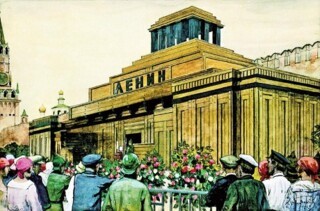Live like Lenin, be buried like Hitler
Nick Richardson
People get uber-tombs when we don’t want to forget them, or when whoever’s in power wants us not to forget them. They’re a way of making sure that the dead don’t fully die, architectural avatars of the values that belonged to the person pickled, withered or wrapped inside. Lenin’s tomb in Moscow, as Gwendolyn Leick points out in Tombs of the Great Leaders: A Contemporary Guide, is a prime example, though its look – squat, windowless, Lego-like – had more to do with Stalin’s take on Lenin’s values than Lenin’s. When Lenin died in 1924 his widow wrote to his successor:
Do not raise memorials to him, palaces named after him, solemn festivals in commemoration of him, etc. Remember how much poverty and neglect there still is in our country. If you wish to honour the name of Vladimir Ilich, build crèches, kindergartens, houses, schools, libraries, medical centres, hospitals, homes for the disabled.
Stalin ignored her. Lenin’s values were eternal so should be represented as a cube, Stalin’s appointed architect Alexey Shchusev suggested, because ‘in architecture the cube is eternal’. The decision damaged the visual language of communism for ever. Ho Chi Minh got a similar pseudo-modernist monstrosity; Mao got one with a pseudo-traditional roof.
The great communist leaders ended up in tombs not unlike the one Hitler had planned for himself. Drawings of the mausoleum that Hitler worked on with Hermann Giesler in the early 1940s show a giant cube, with a dome, that was to form an annex of the Nazi Party HQ in Munich (Hitler had originally wanted to be buried in Linz, like his family, but seems to have changed his mind). A monumental staircase leads up to the sarcophagus and a rotunda topped by two ‘spirits’ bearing the initials ‘AH’.
Mussolini ended up in the crypt in Predappio where his parents and brother were buried. If it weren’t for an oversized bust of the doughy bruiser that stares out over the miniature coffin said to contain his brain, the tomb would have the air, Leick says, ‘of an ordinary family vault’.
Live like Lenin, be buried like Hitler. Or at least like Suharto, who, for all his regime’s iniquities, had the good grace not to inflict a giant cube on his people. Suharto is buried in a building no taller than a suburban semi, with a pointed roof in the style of a traditional Sumbanese clan house and a floridly decorated bronze gate. Leick points out that the building illustrates the ideology behind Suharto’s New Order, his ‘aspirations for a conservative neo-traditionalism achieved with modern technology’. But at least it fades into the surrounding scenery (especially if it's raining), along with any solid notions of what its architects stood for. The problem with a cube is that, though solid notions of what its occupant stood for may be disappearing, the image of his inflexibility remains.
Nine years after Sukarno’s death, Suharto rehabilitated his reputation and commissioned a mausoleum, in the neo-traditionalist style, for the man whose life he had ruined. This tomb now attracts millions of pilgrims a year, while Suharto’s is hardly visited at all. Sukarno's has a museum and a library attached, and a statue of the Father of the Nation surrounded by reliefs of scenes from his life – though like Lenin he’d asked his executors not to bother.

Comments
In Keep the Aspidistra Flying, George Orwell describes the protagonist's ancestor as "a tough old scoundrel. He plundered the proletariat and the foreigner of fifty thousand pounds", buried under a five ton chunk of granite, which:
"was quite certainly put there with the intention, though not the conscious intention, of making sure that Gran'pa Comstock shouldn't get up from underneath it"
As Orwell goes on to write, if you want to know what a dead man's relatives really think of him, a good rough test is the weight of his tombstone.